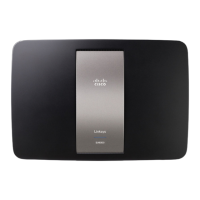
Do you have a question about the Linksys EA6400 and is the answer not in the manual?
| Color | black |
|---|---|
| Wi-Fi Speed | 1600 gigabits per second |
| Wi-Fi Mesh System | no |
| Band Technology | dual |
| Frequency Band | 2.4 ghz |
| Beamforming | yes |
| Ethernet Standard | 10/100 |
| Wireless Standard | ac |
| Antennas | 4 |
| Firewall | none |
| Data Encryption | yes |
| Encryption Type | wpa2 |
| Ports | rj-45, usb |
| LAN Ports | 4 |
| WAN Ports | 1 |
| Built In Modem | yes |
| Smart Applications | true, linksys smart wifi |
| System Requirements | pc: windows xp with service pack 3, vista with service pack 1 or later, 7 or 8; wi-fi capability; cd or dvd drive; mac: os x leopard 10.5.8 or later, snow leopard 10.6.1 or later, lion 10.7 or mountain lion 10.8; wi-fi capability; cd or dvd drive |
| Height | 1.6 inches |
|---|---|
| Width | 7.25 inches |
| Net Weight | 1.1 pounds |
Lists all items included in the router package for setup and use.
Details the router's main capabilities like Wireless-AC, dual-band, gigabit, and USB.
Describes the router's top panel, including the indicator light.
Identifies and explains back panel ports, buttons, and activity indicators.
Instructions and template for mounting the router on a wall.
Defines a network and lists common home network devices.
Outlines the steps and equipment needed to set up a home network.
Provides resources for additional support and documentation.
Step-by-step guide for physically installing and initially configuring the router.
Details how to change router settings for security and performance.
Instructions for accessing and logging into the Linksys Smart Wi-Fi interface.
How to connect directly to the router and improve wireless speed.
Modifying Wi-Fi network name (SSID), password, and router access password.
Setting the router's time zone and testing internet connection speed.
Guide to connecting computers and sharing USB printers.
Connecting other devices like consoles, TVs, and phones.
Instructions for using WPS to connect devices wirelessly.
How to check detailed information about connected network devices.
Configuring parental controls for website and time restrictions.
Steps to set up a separate network for guests with limited access.
Details on enabling and managing guest network access and security.
Saving router settings for backup and restoration.
Customizing the Smart Wi-Fi homepage by adding widgets and devices.
Connecting USB drives for storage and safely removing them.
Setting up restricted access to files and managing authorized users.
Accessing shared folders on the USB drive from within the network.
Configuring the router to stream media files to UPnP/DLNA devices.
Connecting UPnP devices to play media from the router's server.
Accessing the USB drive's contents over the Internet via FTP.
Enabling and configuring the FTP server for remote access.
Advanced manual configuration of router and internet connection settings.
Setting up IPv6 for future-proofing the network connection.
Optimizing performance by splitting traffic between 2.4 GHz and 5 GHz bands.
Using MAC filtering to control which devices can connect to the network.
Setting up the router as a DHCP server and reserving IP addresses for devices.
Configuring built-in firewall settings for enhanced network protection.
Customizing IPv6 port services for applications and security.
Prioritizing traffic for gaming, voice calls, and VoIP services.
Configuring Dynamic Domain Name System for remote network access.
Cloning MAC addresses and configuring VPN passthrough settings.
Managing network traffic priority for real-time applications.
Configuring the router to support VoIP communication.
Enabling Universal Plug and Play for automatic device configuration.
Configuring the router to extend wireless network range.
Scenarios and steps for setting up the router behind another router.
Forwarding specific inbound ports to a designated device on the local network.
Forwarding multiple ports required by certain applications.
Configuring port ranges for applications like online gaming.
Saving and restoring router settings for backup and recovery.
Instructions for updating the router's firmware to the latest version.
Restoring the router to its original factory settings.
Monitoring router status and using diagnostic tools to check connections.
Turning off the status lights on the router's Ethernet ports.
Using built-in diagnostic tools like Ping and Traceroute.
Solutions for when the router fails to set up or connect to the internet.
Troubleshooting "Internet cable not plugged in" and "Cannot access router" messages.
Information on the Service Pack 3 requirement for Linksys Smart Wi-Fi on Windows XP.
Resolving issues with connecting to wireless networks on Windows and Mac.
Steps to reset the router to factory defaults when troubleshooting fails.
Detailed technical and physical specifications of the Linksys EA6400 router.
Details on operating conditions, storage, and certifications.